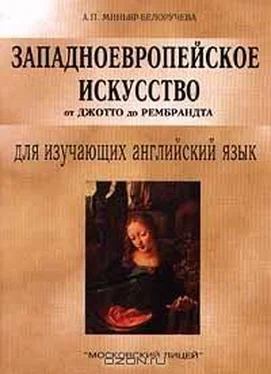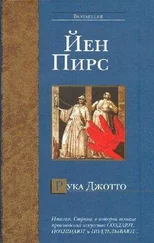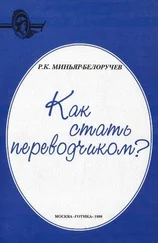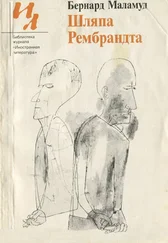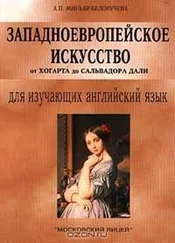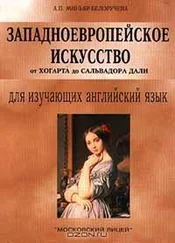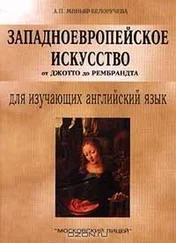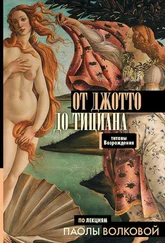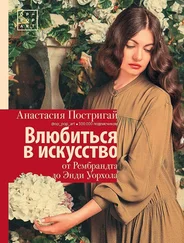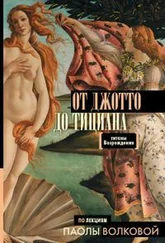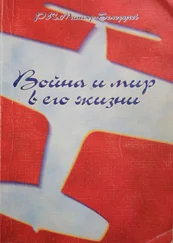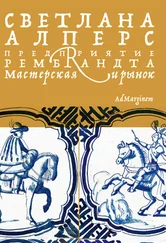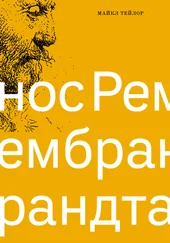A Christianized Venus, modestly dressed and resembling Botticelli's Madonnas, reigns in the midst of a dark grove of trees bearing golden fruit. At the right Zephyrus, the wind-god, pursues the nymph Chloris; flowers issue from her mouth. She is transformed into the goddess Flora, clothed in a flower-covered gown, from its folds she strews blossoms upon the lawn. At the left Mercury is dispelling tiny clouds from the golden apple, the symbol of the Medici family. Between Mercury and Venus the Three Graces dance in a ring. These lovely creatures are shown in transparent garments. This painting is a complex allegory. As in all Botticelli's mature works his figures are extremely attenuated, with long necks, torsos, arms and sloping shoulders. Their beautiful faces and graceful bodies and limbs seem almost bloodless and weightless, their white feet touch the ground so lightly that not a flower or a leaf is bent. The individual forms are perfectly modelled. Botticelli's representation of figures in motion is far beyond anything that preceded him and has never been excelled. The composition is based on an interweaving of linear patterns, drapery folds, streaming or braided hair, trunks, and leaves. Such a picture, both in content and style, represents a withdrawal from naturalism of the Early Florentine Renaissance.
The Birth of Venus may show the effects of Botticelli's residence in Rome in the early 1480s. Venus, according to the ancient myth, was born from the sea. Upon a sea represented without concern for space, and dotted with little V-shaped marks for waves, Botticelli's Venus stands lightly in a beautiful cockleshell, wafted by two embracing wind-gods, toward a highly stylized shore. This Venus, proportioned like the Three Graces, differs from the splendid Venuses of classical antiquity. She uses the curving streams of her long hair to cover her nakedness. She can't wait for the cloak that one of the Hours is about to spread around her. Botticelli's allegory is related to the Christian tradition with which he tried to reconcile the pagan legend. The composition has been compared to medieval and Renaissance representations of the Baptism of Christ. It may be argued that this is a rather artificial interpretation, but it is an interpretation that made sense to the fifteenth century.
Later, under the impact of Savonarola's preaching and the troubles besetting Italy Botticelli's imagery becomes less esoteric and more Christian. The best possible example is the Mystic Nativity . In order to emphasize the importance of the Madonna and Child and the relative unimportance of the humans, Botticelli has reverted to the early medieval device of disregarding scale and perspective and grading the actual sizes of the figures according to their importance; hence the Madonna is far the largest although placed apparently in the middle distance. The feature that links Botticelli most firmly with the Florentine artistic heritage is his linear perspective.
The unreality of Botticelli is a blind alley in the development of Renaissance painting, the brilliance and beauty of his line are not, and it may have influenced the pictorial style of Michelangelo.
Make sure you know the pronunciation of the following:
Sandro Botticelli; Florence; Flora; Graces; Hours; Savonarola; Renaissance; Venus; Christian; Zephyms; Chloris; Mercury
Notes
Primavera (The Allegory of Spring) – «Весна»
Birth of Venus – «Рождение Венеры»
Baptism of Christ – Крещение Христа
Mystic Nativity – «Мистическое Рождество»
Tasks
I. Read the text. Mark the following statements true or false.
1. Botticelli's contemporaries admired his works of art.
2. In the Primavera Christianized Venus reigns on Olympus.
3. Flora, Mercury and Zephyrus dance in a ring.
4. Botticelli's figures are extremely attenuated.
5. In the Birth of Venus Botticelli depicted the sea as a seascape painter.
6. Later in life Botticelli's imagery becomes more esoteric and less Christian.
II. How well have you read? Can you answer the following questions?
1. What glorified Botticelli? What other painters are mentioned in this text? How were they connected with Botticelli?
2. What impact did Savonarola's preaching make on Botticelli?
3. What are Botticelli's most celebrated pictures? How are they interpreted?
4. What gods and goddesses are pictured in the Primavera ? What do they do? What is Botticelli's allegory related to?
5. What is represented in the Birth of Venus ? What gods are depicted in this painting? What do they do? Where is Venus placed? How is Venus proportioned? What differs Botticelli's Venus from the splendid Venuses of classical antiquity? What did Botticelli try to reconcile in the Birth of Venus ?
6. What does the Mystic Nativity exemplify? What device did Botticelli use to emphasize the importance of the Madonna and the Child?
7. Whose pictorial style did Botticelli influence?
III. I. Give Russian equivalents of the following phrases:
poetic (scientific) current; early in life; celebrated pictures; to give up painting; to pursue the nymph; to spread blossoms from the folds; sloping shoulders; a complex allegory; a mature work; on canvas; on panel; in the fresco; in the picture; companion pieces; lovely creatures; drapery folds; an interweaving of linear patterns; classical antiquity; to interpret in different ways; delicate faces; attenuated figures; to be aloof from; transparent garments; a withdrawal from naturalism; wafted to the shore by the wind-god; to reconcile a pagan legend with the Christian tradition; spread a cloak around Venus; to stand in the cockleshell; V-shaped marks for waves; to paint the sea without concern for space.
II. Give English equivalents of the following phrases:
ведущий художник; научное (романтическое) направление; парные работы; знаменитые картины; на холсте; на доске; на картине; на фреске; на рисунке; отход от натурализма; проповеди; разбрасывать цветы; примирить языческую легенду с христианской традицией; зрелая работа; прозрачные одежды; трактовать по-разному; легко касаться земли; перестать писать картины; стилизованный берег; галочки вместо волн; фигуры необыкновенно воздушны; преследовать нимфу; влекомая к берегу; легко стоять в раковине; утонченные лица; переплетение линий; последователь к-л.
III. Make up sentences ofyour own with the given phrases.
IV. Translate the following groups of words into Russian:
Christian – Christianize – Christianity – christianized; reconcile – reconciliation; baptism – Baptist – baptize; reside – residence -resident; preach – preaching – preacher; aloof- aloofness.
V. Arrange the following in the pairs of synonyms:
a) aloof; current; pagan; give up; to dispel; to strew; attenuated; transparent; transform; reconcile; pursue;
b) heathen; trend; distant; translucent; to disperse; to scatter; lengthy; abandon; to transfigure; chase; appease.
IV. Match the names of the gods and goddess with their responsibilities.
Venus (Aphrodite); The Three Graces; Mercury (Hermis); Zephyrus; The Hours (The Horae); Flora
1) the god of the west wind; 2) the goddess of flowering and blossoming plants, shown with a wreath of flowers in her hair; 3) goddesses of season, representing the different times of the year and of the day; 4) the goddess of beauty and love, she emerged from the sea-foam and the winds blew her to the coast of Cyprus; 5) the god of commerce and prophecy, the messenger of the gods and the bearer of the dead souls; 6) goddesses of grace and beauty, who appear in art.
Читать дальше
